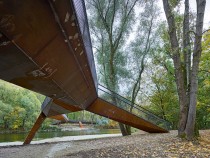
© Bruno Klomfar
The town of Freising has grown much larger over the years; mainly on the right bank of the Isar, the side of the river opposite the town centre. With the completion of the »Isarsteg Nord« (Isar Bridge North), that part of town now enjoys a much better link to the centre. In 2013, the local council issued a Europe-wide tender for the design of the combined pedestrian and cyclist bridge under the VOF procedure.
The winning design by Christoph Mayr, Oliver Englhardt and Josef Taferner appealed to the town council mainly because it interfered to the minimum extent with the natural environment along the Isar and its form integrated subtly into the riverside landscape.
The 160 m long, 58 m main span bridge connects three pedestrian and cycleways and has two sets of stairs and two ramps. The forking form of the bridge is based on a tree branch. The likeness is not limited to the rust-brown colour of the weather-resistant steel, but also its structural concept.
The structural and functional features are combined in the new bridge; the pathways, ramps and stairs also act as spanning and supporting members. The main »bough« and its smaller »branches« are made from the same materials, designed on the same structural engineering principle and connected to one another at the forks by a moment connection. The main path kinks slightly at these points to slow down bridge users in an informal, natural way.
The winning design by Christoph Mayr, Oliver Englhardt and Josef Taferner appealed to the town council mainly because it interfered to the minimum extent with the natural environment along the Isar and its form integrated subtly into the riverside landscape.
The 160 m long, 58 m main span bridge connects three pedestrian and cycleways and has two sets of stairs and two ramps. The forking form of the bridge is based on a tree branch. The likeness is not limited to the rust-brown colour of the weather-resistant steel, but also its structural concept.
The structural and functional features are combined in the new bridge; the pathways, ramps and stairs also act as spanning and supporting members. The main »bough« and its smaller »branches« are made from the same materials, designed on the same structural engineering principle and connected to one another at the forks by a moment connection. The main path kinks slightly at these points to slow down bridge users in an informal, natural way.







